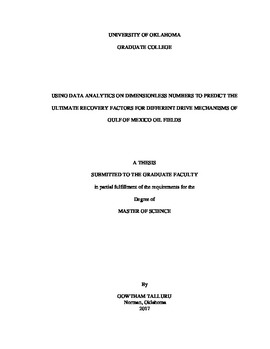| dc.contributor.advisor | Wu, Xingru | |
| dc.contributor.author | Talluru, Gowtham | |
| dc.date.accessioned | 2017-05-15T17:16:35Z | |
| dc.date.available | 2017-05-15T17:16:35Z | |
| dc.date.issued | 2017-05-12 | |
| dc.identifier.uri | https://hdl.handle.net/11244/50878 | |
| dc.description.abstract | The ultimate recovery factor is strongly affected by petrophysical parameters, engineering data, structures, and drive mechanisms. The knowledge of the recovery factor is needed for multiple decision makings and it should be known in the whole development process. This study is to estimate the recovery factor from a different perspective with traditional methods.
This study capitalizes on existing database from the same basin, but explores parametric relationships between different reservoirs using data analytics. Given that there are hundreds of attributes to characterize a reservoir, and some of the records in a database may not be accurate or contradictory to each other, the propose is to use dimensionless quantity first to categorize them based on similarity theorems. Using independent dimensionless variables not only reduces the number of variables for data analytics, but also they have particular physical meanings. This research presents a comparative study of different data mining techniques and statistical significance of various geological, reservoir and engineering parameters. A public dataset related to oil fields in Gulf of Mexico is used for this study.
This dataset consists of 4000 oil reservoirs and each reservoir has 80 attributes. Initial data cleaning was carried out on this dataset to remove reservoirs with erroneous data entries. Dimensionless reservoir parameters are defined and used for the study to make the models consistent to other reservoirs. In the model development, 80% dataset was used to train the model and the rest dataset was used to evaluate the trained models. A few models based on their intrinsic design predicted the ultimate recovery factor with an accuracy of 8-9%, and a few other models predicted the same with an accuracy of 10-12%. Ensemble of a few models predicted oil recovery factor with and accuracy of 6%. In addition to predicting ultimate recovery factor, relative importance of various dimensionless parameters, and sensitivity of ultimate recovery factor to reservoir and engineering parameters is studied. This kind of study uses already available reservoir data to provide a quick means to evaluate new oil reservoirs even with limited data. | en_US |
| dc.language | en_US | en_US |
| dc.subject | Data mining in petroleum engineering, data analytics, dimensionless reservoirs | en_US |
| dc.title | USING DATA ANALYTICS ON DIMENSIONLESS NUMBERS TO PREDICT THE ULTIMATE RECOVERY FACTORS FOR DIFFERENT DRIVE MECHANISMS OF GULF OF MEXICO OIL FIELDS | en_US |
| dc.contributor.committeeMember | Devegowda, Deepak | |
| dc.contributor.committeeMember | Fahes, Mashhad | |
| dc.date.manuscript | 2017-05-12 | |
| dc.thesis.degree | Master of Science | en_US |
| ou.group | Mewbourne College of Earth and Energy::Mewbourne School of Petroleum and Geological Engineering | en_US |
